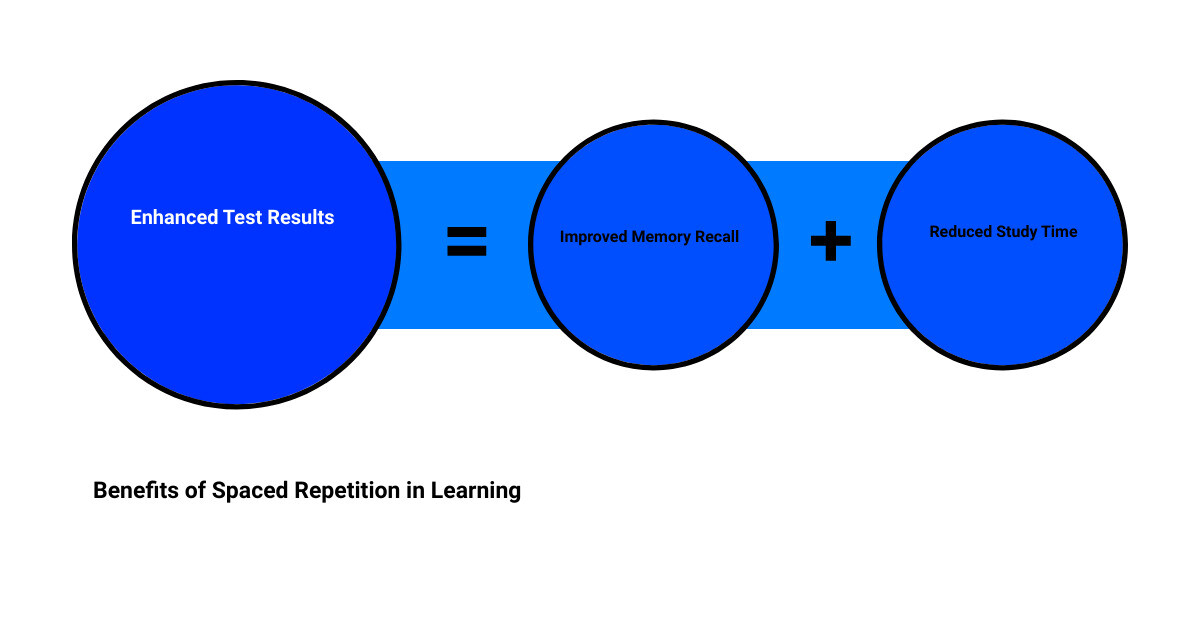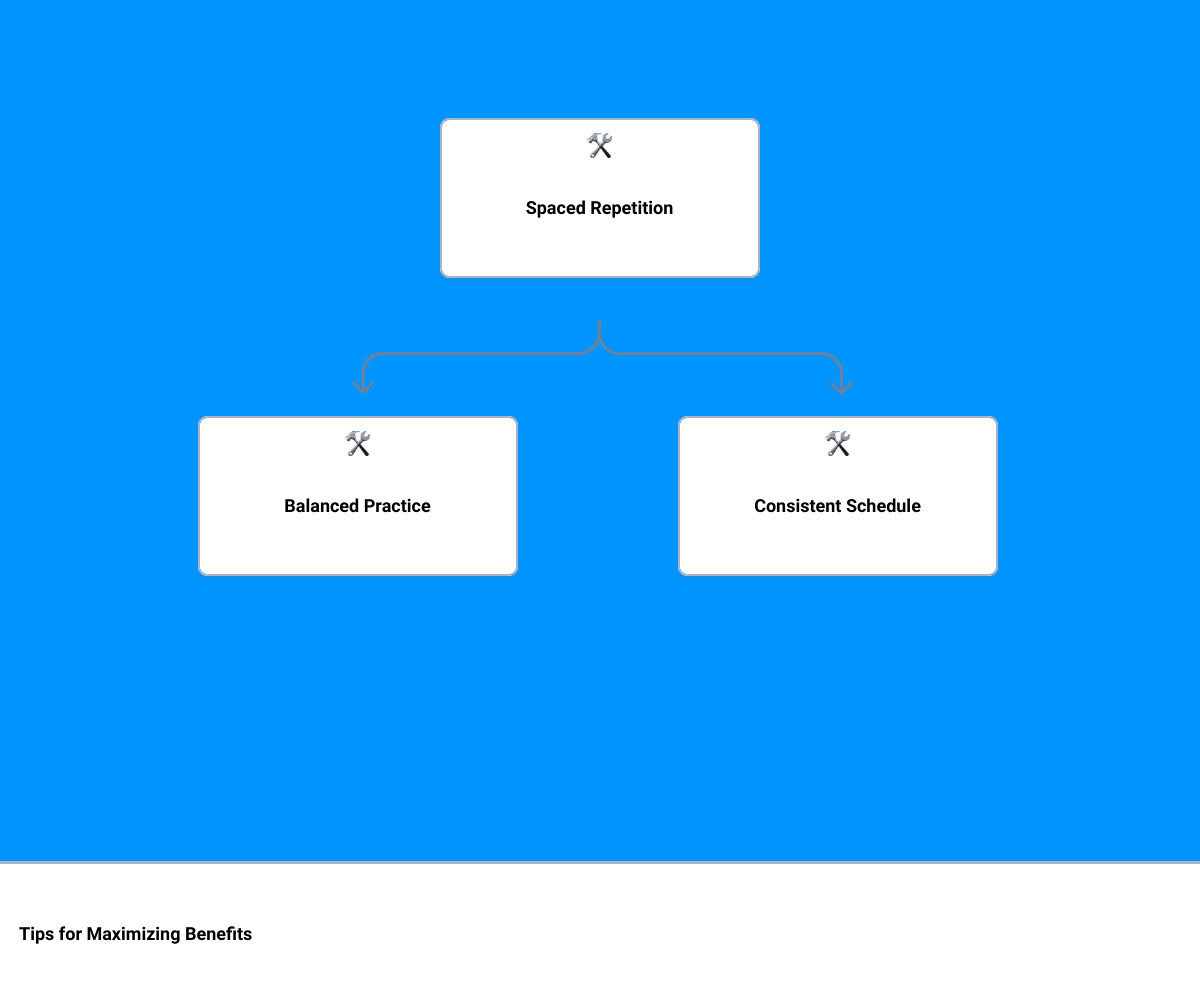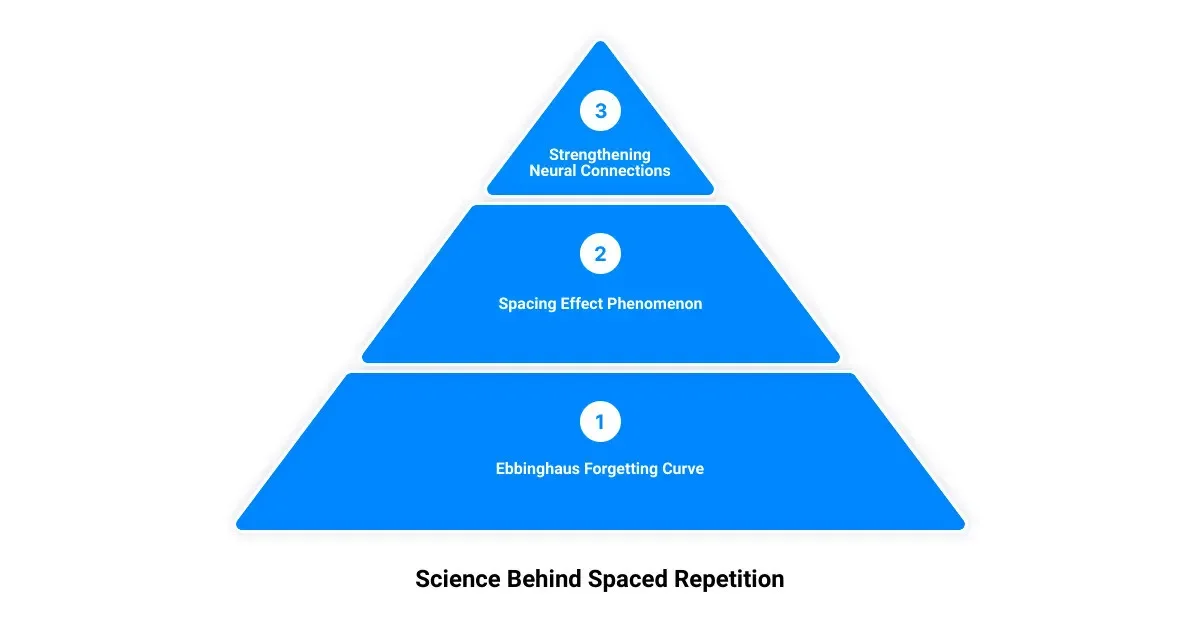Imagine that your brain is a vast, unexplored galaxy. In this galaxy, each star represents a piece of information or knowledge. Now, think of spaced repetition as the spacecraft that allows you to frequently visit these stars, ensuring they shine brighter and last longer in your memory. If you're on a mission to learn Mandarin, including the intricate Chinese characters, or any other complex topic, understanding and leveraging the power of spaced repetition can be a game-changer.
Spaced repetition is a scientifically backed learning technique, designed to enhance long-term memory retention and make your learning journey more efficient and effective. It's about strategically planning your study sessions to match your brain's natural memory processes, thereby reducing the time you spend relearning forgotten information.
This principle is especially beneficial for lifelong learners like you, who appreciate science-backed methods and are interested in the cognitive science behind effective learning. In the following sections, we'll delve into the science behind spaced repetition, its importance in learning, and how to create a spaced repetition schedule. Let's get started on this efficient path to mastering your memory potential.
Understanding the Science Behind Spaced Repetition
Embarking on a journey of learning can sometimes feel like trying to solve a complex puzzle. But with the scientific principles supporting spaced repetition, the pieces fall neatly into place. Let's decode the science behind this powerful learning technique.
The Ebbinghaus Forgetting Curve
Our mental journey begins with a step back in time to the late 19th century, where pioneering memory researcher Hermann Ebbinghaus was conducting his groundbreaking studies. Ebbinghaus developed the concept of the forgetting curve, a vivid representation of how memories fade over time if there's no conscious effort to retain them.
The curve starts steep, indicating a rapid memory loss just after learning. However, it gradually levels off as time progresses. The Ebbinghaus forgetting curve paints a picture of the human memory process, where information is lost over time when there's no attempt to retain it.
The good news is that this memory decay can be slowed down. By reviewing the information at strategic intervals, the steep forgetting curve can be 'reset'. This process serves as the fundamental basis for spaced repetition learning, where timely reviews are used to boost memory retention.
The Spacing Effect Phenomenon
A critical principle that underpins spaced repetition is the spacing effect. This phenomenon suggests that our brains learn more effectively when our study sessions are spread out over time. This spacing effect allows our mental 'mortar' to dry, solidifying new knowledge and making the learning process more effective.
The spacing effect goes hand-in-hand with the concept of desirable difficulty, a principle that suggests learning is most effective when it's challenging, but not too hard. Spaced repetition, with its gradually increasing review intervals, provides just the right amount of challenge to keep our brains engaged and our learning optimized.
The Role of Spaced Repetition in Strengthening Neural Connections
Spaced repetition has a significant role in triggering cellular mechanisms in our brains that aid in the formation and maintenance of long-term memories. When we repeatedly encounter the same information, our brain perceives it as something more important compared to a lesson studied only once.
This technique allows us to revisit a piece of information at spaced intervals, enhancing our memory by increasing the storage strength of the information in our brains. The act of recalling information strengthens the neural connections, making it easier to retrieve and recall the information at later dates.
In essence, understanding and leveraging the Ebbinghaus forgetting curve, the dual strength theory, and the spacing effect can transform the way we learn and remember. This science-backed approach is what makes spaced repetition a powerful tool in your learning arsenal, whether you're tackling Mandarin with Traverse or any other area of study.

The Importance of Spaced Repetition in Learning
Seize the day, seize the knowledge! Unleashing the power of spaced repetition in your learning journey can lead to incredible benefits. Whether you're learning Mandarin or mastering a new skill, spaced repetition can play a crucial role in enhancing your learning efficiency. Here's why.
Improving Long-Term Memory Recall
One of the main benefits of implementing spaced repetition is its impact on long-term memory recall. When you review or use information over spread-out intervals, it becomes deeply embedded in your long-term memory. This is due to the spacing effect phenomenon, which suggests that our brains learn more efficiently when we spread out our study sessions over time. So, whether you're trying to remember the strokes of a complex Chinese character or the syntax of a coding language, spacing out your sessions will help you remember for longer.
Reducing Study Time
The next time you find yourself crambling to cram for an exam or a presentation, consider this: spaced repetition can help reduce your study time. Yes, you read that right. A 2015 study by researchers at York University in Toronto showed that students who took an online quiz eight days after a lecture performed significantly better than those who took it only a day after. This approach, which involves multiple short review sessions, is more efficient than going over the same learning material for long hours, which can often lead to fatigue and reduced retention.
Enhancing Test Results
There's more to spaced repetition than just improving memory and saving time. It can also significantly enhance your test results. In a 2020 study at the University of Leicester, students who used a spaced repetition timetable scored an adjusted mean exam score of 70%, the highest among all groups. This proves that learners who apply spaced repetition to their studies have the best test results.
The Effectiveness of Spaced Repetition for ADHD Learners
Learning can be particularly challenging for individuals with attention deficit hyperactivity disorder (ADHD). However, spaced repetition can be a game-changer. Breaking down large tasks into smaller, manageable chunks, also known as chunking, can make the learning process more manageable for ADHD learners. This approach, combined with the predictable schedule of spaced repetition, can help to improve focus, engagement, and ultimately, learning outcomes.
In conclusion, whether you're looking to improve memory recall, reduce study time, enhance test results, or aid learning in ADHD individuals, spaced repetition can be an invaluable tool in your learning toolkit. Start implementing it in your study schedule today and unlock your memory potential!

How to Create a Spaced Repetition Schedule
Unlocking your memory potential starts with creating an effective spaced repetition schedule. This systematic approach to learning can enhance your recall and aid in your efforts to master complex subjects like Mandarin. Let's dive into the key steps involved.
Planning the Spacing Intervals
The first step in creating a spaced repetition schedule is setting up your spacing intervals. These are the periods between your study sessions and they are crucial for ensuring you engage with the study material just as you’re about to forget it. This helps reinforce the memory, making it stronger each time. The optimal intervals may vary, but a commonly used algorithm suggests repeating the information on the first, seventh, sixteenth, and thirty-fifth day after learning.
Reviewing and Studying the Information for the First Time
Once you've set your intervals, it's time to begin reviewing and studying the information. This first look at your study material lays the foundation for your spaced repetition schedule. Aim to understand the concepts thoroughly this first time around. This initial session should be slightly shorter than subsequent ones, so more effort will go towards recalling information rather than learning new material. This ensures that the following repetitions will have fresher content to build off of each other without interference from previously learned concepts.
Recalling the Information at the First Spacing Interval
After your first study session, the next step is to recall the information at your first spacing interval. This process of active recall strengthens the memories you formed during your initial review and helps to solidify your understanding of the concepts. This first repetition should be more about recalling than learning, which will make your subsequent study sessions more efficient.
Continuing to Recall the Information at Chosen Spacing Intervals
Having finished your first repetition, the next step is to keep repeating this process at the spacing intervals you set. Stick with your schedule and trust in the system. Remember, spaced repetition takes time to show results, but once it does, you’ll start to see significant improvements in your ability to recall and retain information. This method isn't magic - it requires consistency, effort, and a commitment to your learning journey.
By following these steps, you can create a robust spaced repetition schedule that aligns with your learning goals. Whether you're studying Mandarin characters or exploring the depths of advanced physics, spaced repetition can help you master the material and unlock your memory potential.

Tips for Maximizing the Benefits of Spaced Repetition
Unlocking your memory potential with spaced repetition is like finding the golden key to learning efficiency. However, to truly tap into the power of this scientifically-backed technique, there are a few best practices you should follow.
Practicing at a Balanced Level
Think of your brain as a gymnast on a balance beam. Leaning too far in either direction can lead to a fall. Similarly, your recall success and error rates should be in equilibrium. If the learning process becomes too easy, your brain won't exert effort in retrieving the information, making the learning less impactful. On the other hand, a high error rate can lead to frustration and a drop in motivation. The trick is to challenge your brain enough to make the neural pathways work and strengthen over time without overwhelming it.
Sticking with the Schedule
Spaced repetition is not a sprint; it's a marathon. The path may seem long and sometimes difficult, but sticking to the schedule is crucial for reaping the benefits. Remember, those moments of struggle to recall information are signs that your brain is working hard to cement the knowledge into your long-term memory.
Understanding that Spaced Repetition Takes Time
The beauty of spaced repetition lies in its gradual, consistent exercise of the brain. It is not a quick fix or a shortcut to learning. Instead, it is a long-term commitment that requires time and effort. But rest assured, the results - increased recall and understanding - are well worth the investment.
Setting Up a Comfortable Study Environment
Your external environment plays a significant role in your learning journey. A well-organized, distraction-free, and comfortable study space can boost your focus and absorption of information. Ensure your study area is quiet, well-lit, and equipped with all the resources you need for effective learning.
Trying Different Methods such as Flashcards and Traverse App
Flashcards are a popular tool for spaced repetition. They are especially effective for subjects like language learning, where you are memorizing discrete pieces of information. However, for complex subjects that require a deeper understanding, you might need to experiment with other methods. The Traverse app is a powerful technology-enhanced learning tool that combines mind mapping, connected note-taking, and spaced repetition flashcards, offering a holistic approach to effective learning.
In conclusion, while applying the spaced repetition technique to your study routine, remember to keep these tips in mind. They will help you maximize the benefits of this powerful learning method and set you on the path to mastering Mandarin or any other subject that piques your interest.
Using Traverse App for Spaced Repetition
Overview of Traverse App
Navigating through the world of learning can be a maze. But, fortunately, the Traverse app is here to guide you. Traverse is not just any learning app; it's a tool that blends the power of mind mapping, spaced repetition flashcards, and connected note-taking all in a single platform. Built to make learning more efficient and more engaging, Traverse leverages evidence-based techniques to help you not just learn, but master new information.
How Traverse Combines Mind Mapping, Spaced Repetition Flashcards, and Connected Note-Taking
Imagine having a digital brain in which you can store and organize information, visualize connections, and reinforce learning through repetition. Traverse offers exactly that. The app's mind mapping feature allows you to create nodes of information and link them in a way that mirrors the natural wiring of your brain.
But Traverse isn't just about mind mapping. The app also incorporates spaced repetition flashcards, designed to help you retain information for longer periods. The flashcards follow a scientifically validated schedule that reinforces your memory just as it's about to fade, thereby solidifying your learning.
Lastly, the connected note-taking feature allows you to jot down your thoughts and observations as you learn. This encourages active learning, which is known to significantly increase comprehension and recall.
The Benefits of Using Traverse for Mandarin Learners
Are you on a journey to master Mandarin? Then Traverse can be your trusted companion. Not only does the app provide the tools to organize and memorize thousands of Chinese characters, but it also makes the process enjoyable and less overwhelming.
Traverse's mind mapping feature can help you visualize the connections between different characters and words, making it easier to remember them. The spaced repetition flashcards can then reinforce these memories, ensuring they are transferred to your long-term memory. And with connected note-taking, you can jot down any tips or tricks you come across for remembering particular characters, making your learning experience truly personalized.
How to Import Anki Decks into Traverse for Continued Learning
For those familiar with Anki, you'll be glad to know that Traverse is 100% Anki-compatible. You can import your Anki decks into Traverse, including images and other media. This seamless integration allows you to continue your learning journey on a more sophisticated platform without losing any of your previous progress. All you need to do is remove the scheduling information from your Anki decks to ensure they import correctly.
By using the Traverse app for your spaced repetition schedule, you are unlocking the door to a more efficient and effective learning experience. Whether you are a Mandarin learner or a lifelong student of any subject, Traverse offers the tools to help you master your learning journey.
Conclusion: Unlocking Your Memory Potential with Spaced Repetition
Harnessing the power of spaced repetition is like discovering a secret key to a treasure chest of knowledge. This scientifically-backed learning technique doesn't just make memorization easier, it makes it smarter, more efficient, and more results-driven. Once you've mastered the art of creating a spaced repetition schedule, you'll find that the elusive language of Mandarin, with its complex characters, or any other challenging subject, becomes an exciting puzzle to solve rather than an insurmountable mountain to climb.
The beauty of spaced repetition lies in its adaptability. It can be applied to any form of education, from grade school math problems all the way up to graduate computer algorithms. It's not just about repetition; it's about the strategic spacing of those repetitions to maximize memory retention. It's a method that respects the natural rhythms of your brain, helping you retain information in your long-term memory while reducing the overall amount of time spent studying.
Remember, the purpose of spaced repetition is not to make studying easy. In fact, the principle of desirable difficulty suggests that a certain level of struggle in recalling information is beneficial for learning. This is where spaced repetition truly shines. Through calculated intervals of forgetting, spaced repetition introduces a desirable level of difficulty in recalling information, thus enhancing memory strength.
Implementing a spaced repetition schedule requires discipline and intentionality. It's an investment of time and effort, but the returns on this investment are substantial. Whether you're using flashcards or leveraging the power of innovative tools like the Traverse app, spaced repetition is a proven strategy to boost your learning capabilities and unlock your memory potential.
In conclusion, the journey to mastering Mandarin or any other subject doesn't have to be a lonely uphill battle. With spaced repetition, you're not just studying harder, you're studying smarter. So, embrace the challenge, stick with your schedule, and watch as your memory potential unlocks new learning horizons.
Remember, the key to unlocking your memory potential isn't found in a one-size-fits-all solution. It's found in understanding how your brain works and tailoring your study techniques to maximize your memory retention. So, give spaced repetition a try and experience the transformative effects of this powerful learning technique.

